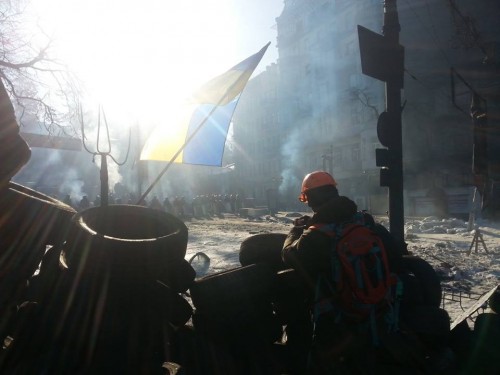Varför våld?
Category: by oleksiy radynski, by sophie engström, ukraina
Tags: #euromaidan, Kyiv, Oleksiy Radynski
En fråga som säkert många ställer sig är varför de fredliga demonstrationerna i Kyjiv plötsligt blev våldsamma i mitten av januari. Det finns ju flera svar på den frågan, men för det första började våldsamheterna redan den sista november när kravallpolis slog ner demonstranter, många av dem studenter. Sedan eskalerade polisens våld den första december och det finns massor av exempel på våld mot äldre, journalister eller helt försvarslösa människor.
Men plötsligt hände något. Demonstranterna började använda våld för att försvara sig mor polisens våld. Och trots att polisen använda gummikulor gav sig inte upprorsmakarna. De gav sig inte ens när unga människor blev ner skjutna på barrikaderna. Euromajdan hade radikaliserats och ytterst ansvarig för det är presidenten själv. Genom att målmedveten ignorera folkets röst, och samtidigt skonlöslöst suga ut det fattiga landet Ukraina och våldföra sig på sin egen befolkning, har han skapat en liten men bestämd folkarmé. En armé som inte tänker ge upp, och inte är rädda för att förlora sina liv i kampen för ett bättre land.
I gårdagens Time World kan man läsa en intervju med Högra sektorns ledare. Högra sektorn är ett exempel på dem som vill ha ett militäriserade uppror. Men de är just bara ett exempel och en del av upproret. De ska inte ses som en ensam representant för alla som står på barrikaderna.
Om man vill få en bättre förståelse för vad som händer i Kyjiv så ska man följa Oleksiy Radynski, som också finns på youtube. Oleksiy Radynski är aktivist och filmare som genom sina filmer visar på den pluralitet som finns på Euromajdan och på barrikaderna i Kyjiv. Det finns en klarsynthet och värme i hans filmer som få andra klarar av att ge. Den senaste filmen har engelsk undertext och rekommeneras av man verkligen vill förstå vad som händer i Kyjiv.
Om man vill läsa mer om brott mot ukrainska medborgare kan man besöka Crimes against Ukrainian people på Facebook.

Foto: SILBADK


